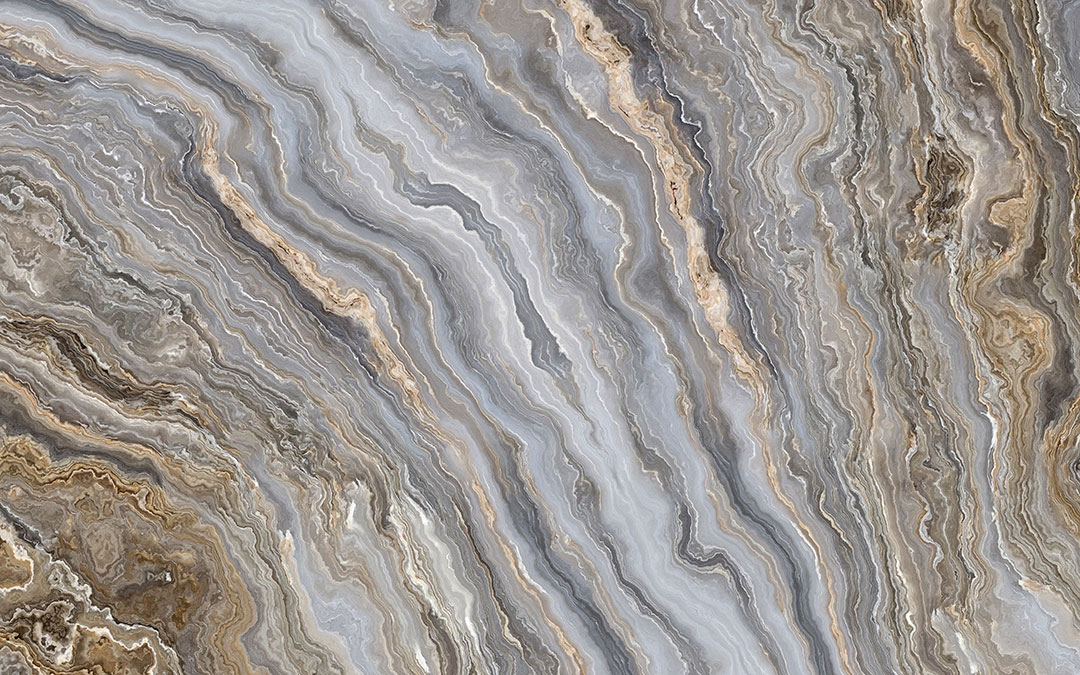Today I’ll be tackling the tile industry’s hot topic: NATURAL STONE. With a whirlwind of conflicting ideas out there about the delights and dilemmas of natural stone tile, I’ll clarify the myths and share the facts. I’ll explain key differences between natural (quarried) stone and its man-made (engineered) competitors like ceramic and porcelain. I’ll compare tile products according to predictability, maintenance, and cost, and will offer some online resources and tile selection tips.
Unlike engineered tile, natural stone tile is sourced directly from the earth as is. The stone is extracted from an open-pit mine called a quarry. Once the stone is quarried, it’s then machine cut into tiles or slabs, without altering the internal fabric of the material. Although natural stone is in a category of it’s own, there are a multitude of different materials under the natural stone umbrella. Natural stone tiles most commonly include marble, limestone, travertine, slate, quartzite, sandstone, and onyx. Attributes like color, veining, shade variation, and natural fissures can range tremendously with natural stone. Thus, the rule of thumb when choosing stone is to expect and embrace the unexpected. What you see isn’t necessarily what you get. Or, more precisely, what you see in the tile showroom may only reveal a fraction of what you end up with. That unpredictability may sound like a deal-breaker, but to the well-informed natural stone consumer, it’s the main draw.
“Embrace the risks of natural stone! You can’t beat the real deal. Stains and scratches are part of the charm.” JT Christensen, Design Consultant, Architectural Ceramics
Nature lovers, be advised! The allure of natural stone is not geared specifically toward the naturalists nor the habitually stoned. It is the educated and accepting consumer who will best grasp the dazzling thrill of real stone. Stone is riddled with magical quirks and inherent defects, some of which can even make it rather forgiving at times. No piece is identical. Thus, perfection is never an option, and character is always a given. JT Christensen, a fellow marble lover and Design Consultant at Architectural Ceramics, believes “you can’t beat the real deal,” when it comes to natural stone. I must agree. There is some crazy stuff set in stone! The tiny fissures, holes, chips, veins, and striations are what make stone so fascinating. In more rustic stones, these kinks and curves can even mask dirt and household stains. The brushed and cobbled travertine on my own kitchen floor was selected intentionally to hide the tracks of mud-ridden soccer cleats. However with smoother, lighter, or more uniform stones like marble, the imperfections may be too dramatic for everyone to enjoy. The unbridled love some have for natural stone is purely subjective. I am a huge fan of the visual drama of natural stone. To me, the random fossilized marks and the colorful flow of the veining in stone tell a mysterious geologic tale. It fascinates me to think one can look at a piece of marble and witness the outcome of millions of years of metamorphic changes in the earth. That’s one type of groovy drama you cannot get from engineered products. I suggest any stone-seekers do a little self evaluation on how much visible drama you want for your tile project. If you can handle a decent dose, then we’re ready to move on to stone maintenance.
Like a beloved spouse (or pet), stone will always involve effort and care, both now and later on. In tile terms, this means during installation for the installer, and long term for the client. Applying a sealer at installation will reduce maintenance, but some level of staining, scratching, and aging is to be expected with stone. Because natural stone is intrinsically porous, the pores can be filled with sealer, which is usually applied at installation. Sealer will likely need to be re-applied again over time, and sealer cannot protect against steam or vapor particles due to their microscopic size. Generally a penetrating sealer will be most effective against water and stains. CTEF (Ceramic Tile Education Foundation) outlines the difference between two main types of sealers: a topical sealer and a penetrating sealer, explaining “topical sealers reside on the surface of the tile and tend to require routine maintenance and resealing as it wears off. They block stains and provide either a matte, semi-gloss or gloss finish. Penetrating sealers enter into the pores of the stone which normally will not change the appearance of the stone and tend to require less routine maintenance.” It’s wise to purchase the sealer specified by the stone tile supplier or manufacturer’s installation instructions. Penetrating sealers are sometimes referred to as impregnators or impregnating repellants. Yes, I’m serious, and no, I did not name them. They were named long before the #metoo movement, and despite the predatorial names, these sealers are safe products for stone. The frequency of reapplication of sealer will depend on how often surfaces are cleaned and used. Sealers are not typically required on engineered tile, but will help protect the grout from staining (in grout that doesn’t already contain a stain-resistant component.)

Steven Bailey, of Architectural Ceramics, flaunting their large porcelain panels.
One surprisingly beneficial trait of natural stone is that the surface can be restored, at least to some extent. Superficial defects can be remedied with restoration methods. Many types of aged stone can be buffed and polished by a stone restoration company, much like hardwood floors can be refinished. Stone restoration by specialized companies can also include using a poultice to remove certain stains. However, some blemishes are more complex to resolve. Stone may contain trace deposits of elements like iron, which can oxidize over time and result in color change, especially in wet areas like showers. With the popularity of white marble in shower areas, the issue of yellowing or discoloring from oxidation is becoming more prevalent. We’ll discuss iron oxidation in more depth in future posts (since it requires a geology lesson.) For now, just expect more maintenance with natural stone than with engineered tile. A wise friend and tile industry colleague from Italy, Barbara Mion of Mosaic Tile Co, puts it very simply, when she says “Il marmo si invecchia con la famiglia.” That translates to “marble should age with the family.” The Italians are pretty enlightened when it comes to marble and vino. They’re both expected to age and change gracefully, just like people. Marble doesn’t need to be replaced just because it ages. Having lived in Italy amidst ancient stone installations, I can vouch for the endearing and dynamic character of aging stone. Perhaps acceptance is the great lesson we can derive from natural stone. If acceptance is not your strong point, well… don’t quarry, be happy! You’ve still got options, as you step away from the quarry, and toward the factory. See for yourself in this pic of Steven Bailey, tile fashionista and Floor Manager of Architectural Ceramics as he flaunts the revered Bethesda showroom backdrop. This large tile panel display screams of swanky marblesque qualities, yet it’s actually porcelain!
Engineered tile can be divided into porcelain and non-porcelain products. For detailed info, TCNA (Tile Council of North America) offers great insight on the different types of engineered tile, but here’s the quick and dirty; Porcelain is generally dense, durable, and often frost resistant, making it an easy pick for high traffic area floors like kitchens, commercial installations, and even exteriors. Porcelain comes glazed and unglazed, with the glazed variety typically boasting lower maintenance. Most of what you see in current tile showrooms is glazed. Glazed porcelain is non-porous and rarely requires sealer. It’s super easy to clean, and is generally scratch resistant. Real porcelain tile is an excellent option for those seeking reliability, predictability, and durability. Porcelain tile is one of the densest and lowest maintenance finishes in the construction industry, and is a top choice for those who love cooking and spilling, but hate cleaning and scrubbing. In November 2007, CTDA (Ceramic Tile Distributors Association) and TCNA jointly launched PTCA (Porcelain Tile Certification Agency), not because they love unpronounceable 4-letter acronyms, but they wanted to certify porcelain tile. This deterred manufacturers from calling tile “porcelain” if it wasn’t, and it ensured the tile sales force was educated on the difference between porcelain and ceramic tile.
Ceramic tiles are generally less dense than porcelain. Ceramic tile often does not require a wet-saw to cut, so installation of builder’s grade tile, may be less expensive. Some ceramic tiles are not floor-rated because they lack the durability, density and other characteristics needed for a floor finish. That doesn’t mean ceramic tile isn’t a highly desirable product. In fact, colorful, hand-painted ceramic tiles are great contenders for backsplashes and wall surfaces where design options are the driving force. Glass tile is also a great manufactured option for many wall surfaces. Your tile vendor should advise you as to the suitability of each product. Next we have quarry tile, yet another confusingly named product in the tile industry. Quarry tile is actually not a natural quarried material like genuine natural stone. Shocker! Quarry tile is a manufactured product, usually thicker than the typical 3/8″ tile, made by extruding or forming and firing natural clay or shales. It’s often found and specified in commercial installations, as it is functional and durable, but doesn’t tend to offer a grand array of current aesthetic options like porcelain.
“What you see is what you get with porcelain. It’s affordable and reliable.” Desiree McCrorey, Design Consultant, Architectural Ceramics
Porcelain obviously has the edge when it comes to durability and maintenance, but it also offers an abundance of snazzy style options. Even for those who wear fancy pants, don’t be too quick to snub porcelain just because it’s not real stone. Porcelain tiles can include an array of fashionable finishes that resemble diverse textures like linen or silk, or have bumps or waves or ridges or stripes, and so much more. Desiree McCrorey, another innovative tile guru at Architectural Ceramics, points out that porcelain is known for being both “affordable and reliable.” The 12″x24″ samples she holds are top sellers among the practically-minded. Many porcelain options can resemble stone, while providing a much more predictable outcome. The variation in a series of porcelain tile is limited to the templates in that series.
Engineered products will generally have a range of different templates within each series. Vendors may offer sample boards, showroom vignettes, or marketing photos to display range of shades and patterns for each line of tile. I recommend looking at physical samples as well as installation photos to understand the visible range of one tile. Much like stone, porcelain tile may have some variation, but it will be predictably based on a finite number of templates. Some of today’s porcelain tile is almost impossible to distinguish from genuine stone, especially once installed. Sometimes installers can’t even tell the difference without having the tile in hand. The porcelain tile market has created products convincing enough for even the shrewdest tile aficionado, even myself. There’s been an explosion of porcelain versions of the most popular natural stone products, making the decision between stone and porcelain much less about form and more about function and maintenance, and of course, cost.
Cost is indeed a factor, but surprisingly not the deciding factor for most of our clients. This is likely because the cost difference between porcelain and stone can vary drastically per tile selection. As a general rule, stone tile is more expensive than porcelain tile. The visible differences between porcelain and stone tend to become less obvious as you get into the high end porcelain lines. I’ve seen very convincing versions of porcelain made to look like trending marbles such as Calacutta Gold and Carrara. However, a pricey 12″x24″ porcelain usually caps off around $15/SF where a similarly sized real marble tile, such as Calacutta Gold, can easily run around $45/SF. Less expensive crosscut limestones and travertines, as well as less expensive porcelain tile, may run around $3-$5/SF. However, you tend to get what you pay for. Very inexpensive stone tiles may be non-rectified (lacking perfectly square edges) or display other irregularities. Mid range products like vein-cut limestones tend to start around $10/SF, while many standard porcelain tiles run in the $5-$10/SF range. The cost difference between stone and porcelain is most notable on higher end products, with most dramatic marbles being the highest, and the least common to have porcelain replicas. Overall price must also take into account labor. Installing stone tile is generally more expensive than installing porcelain, especially when hand selecting is requested by clients. The installer often has to inspect stone pieces much more thoroughly for chips, fissures, or breakage, and has to be much more strategic about creating a consistent flow with stone than with porcelain. While porcelain installation, like marble, requires a wet-saw, it generally does not require the application of sealer since it’s non-porous. All of these factors increase the labor price for stone tile.
I am a definitely a fan of natural stone, but I know what to expect with stone, and I can appreciate its imperfections. Knowing not all people feel this way, I advise clients to consider the long term outcome of their selection and ensure they’ve been educated about the typical attributes of their tile. Maintenance is always an important consideration. This is precisely why tile is still the top choice when compared to other floor finishes. Tile also offers an unbeatable return on investment for home resale value. For a list of the many benefits of tile vs. other wall and floor coverings, you can sneak a peek at Why Tile®. This site is full of useful info about creating healthy tiled spaces, tile design ideas, care, maintenance, and even the heritage of tile.
Once you’re ready to choose tile, here are our tile shopping tips to ensure a fruitful process:
- Request current lot samples from your salesperson. This is extra important with natural stone. Tile showrooms or websites may not update samples or digital photos regularly. I suggest requesting samples from the existing lot once you’re ready to order. If you get a sample and wait weeks or more to order, check that the lot has not changed before ordering.
- Ask for a range of samples that reflect typical shade variation for your particular stone or tile. Although I don’t recommend photos for showing true color, they can be helpful for showing the variety of visible differences both within and between tiles from one series and color. Some tile vendors even provide a rating system for shade variation which reflects the amount of visible diversity within one lot of tile.
- Hold a few tiles in your hands. With natural stone, color is not the only thing that can vary. Products like slate and sandstone may also have a range of thicknesses. This is part of it’s rustic charm. Understand it may not be gauged or level. It may have a rough, textured surface from when it was cleft from larger pieces of slate after being quarried. Cleft slate can vary from 1/8″ to 3/4″ thick in extreme circumstances. It is not uncommon for tile vendors to ask you to sign a waiver accepting the limitless variation that can come from natural stone.
- Be wary of shopping on the internet for stone tile unless you’re familiar with the vendor. Check reviews and be willing to pay extra for samples to be shipped to you before placing an order. If at all possible, I recommend purchasing from an established local tile vendor in your area for the best service and recourse if there’s a problem during installation. Reputable tile vendors will educate their clients on the attributes of tile they sell. As an educated consumer, be open to asking your tile vendor questions about your selections before you purchase.
As with any tile selection, I advise clients set an intention for their space. Consider for what purpose, what people, and what activities this room will be used. Then go a little deeper. Decide on the mood you want this room or surface to embrace. Will it be calming and relaxing, joyful and uplifting, loud and entertaining, or thought-provoking and inspiring? Having a set intention makes decision-making an easy and intuitive process. The most meaningful spaces start with a clear intention. Stay tuned for our next post of Intentional Spaces.







